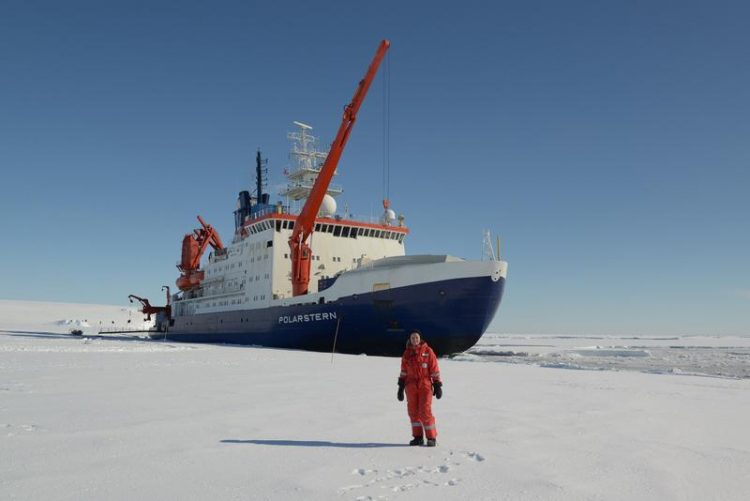Icebergs: Mathematical model calculates the collapse of shelf ice

Julia Christmann in front of the icebreakter "Polarstern" in the Antarctica Credit: Julia Christmann
The ice rises up like a sheer cliff face – shelf ice is not only several thousand square kilometres large, it is also more than a hundred metres high in many places. From time to time, pieces break off the edge and crash into the sea below, where they float away in the ocean as icebergs. This was also recently the case with the Larsen C ice shelf.
Science is unable to accurately predict when and where the ice shelf will break. “Assumptions were always previously based on observations by glaciologists and other researchers. Concrete calculations with physical parameters did not exist,” says Julia Christmann, who is researching technical mechanics at the University of Kaiserslautern with Professor Dr Ralf Müller. As a rule of thumb, she explains, the ice tends to break where it is thinner than 200 metres; in reality, however, there are also many ice shelves that are even thinner.
The calving of ice sheets is a continuous process that is influenced by a number of different factors. Satellite data was also used in order to observe this natural spectacle. “However, they only offer snapshots of the process,” Christmann adds. As part of her doctorate research, she has developed mathematical models to calculate when and where the ice shelf may collapse. A range of different physical factors are germane here.
“The thickness and density of ice can play an important role, for example,” Christmann continues. “The material parameters are also critical, including elastic factors. These mainly influence where the iceberg is calved. There is also the viscosity, which affects the time between break-off events.”
The doctoral student at Kaiserslautern was also supported in her work by Professor Dr Angelika Humbert from the AWI. Humbert is an expert in the field of glaciology. She is also occupied with the properties and motion of giant ice sheets on the Antarctic continent, which constitute 70 percent of the entire supply of freshwater on the planet.
“The ice shelf generally breaks at points that are between a half and full thickness of the ice sheet from the edge,” summarises Christmann. This data may be particularly important for the scientific community, since numerous research stations are located on ice shelves in Antarctica. This includes the German Neumayer Station III or the British station, Halley VI, which was closed for winter this year due to a crack in the ice.
Christmann recently completed her doctoral thesis. She is continuing her research on the properties of ice. She is now focusing on grounding lines in Greenland. This refers to the area in which the ice still touches the ground and merges into floating shelf ice. The researcher intends to find out how these lines change over the course of time.
For enquiries:
Dr Julia Christmann
Technical Mechanics
TU Kaiserslautern
Tel.: 0631 205-2126
Email: jchristm[at]rhrk.uni-kl.de
Media Contact
More Information:
http://www.uni-kl.deAll latest news from the category: Earth Sciences
Earth Sciences (also referred to as Geosciences), which deals with basic issues surrounding our planet, plays a vital role in the area of energy and raw materials supply.
Earth Sciences comprises subjects such as geology, geography, geological informatics, paleontology, mineralogy, petrography, crystallography, geophysics, geodesy, glaciology, cartography, photogrammetry, meteorology and seismology, early-warning systems, earthquake research and polar research.
Newest articles

Pinpointing hydrogen isotopes in titanium hydride nanofilms
Although it is the smallest and lightest atom, hydrogen can have a big impact by infiltrating other materials and affecting their properties, such as superconductivity and metal-insulator-transitions. Now, researchers from…

A new way of entangling light and sound
For a wide variety of emerging quantum technologies, such as secure quantum communications and quantum computing, quantum entanglement is a prerequisite. Scientists at the Max-Planck-Institute for the Science of Light…

Telescope for NASA’s Roman Mission complete, delivered to Goddard
NASA’s Nancy Grace Roman Space Telescope is one giant step closer to unlocking the mysteries of the universe. The mission has now received its final major delivery: the Optical Telescope…



